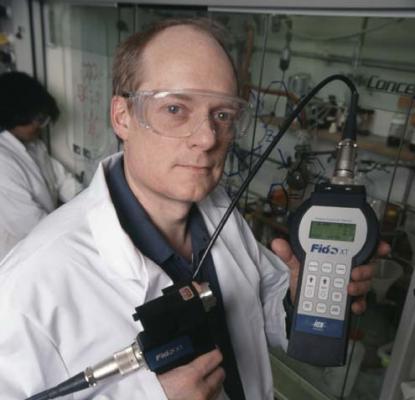Timothy M. Swager
Timothy M. Swager intended to become a rancher. Growing up in Sheridan, Montana, a town of 600 people, he spent summers as a teenager working on the ranch owned by the family of his future in-laws.
But Swager has come a long way from his ranch-hand days. Now the John D. MacArthur Professor of Chemistry at the Massachusetts Institute of Technology, he is being recognized with the $500,000 Lemelson-MIT Prize for his inventive accomplishments that stem from original molecular-based designs.
Swager sees many parallels between being a successful rancher and an accomplished scientist and inventor. "When you're on a ranch, you're very independent," he said. "That's kind of the mindset of a rancher. They just feel, as far as the eye can see, I rule this land. They're unbounded, just like scientists sometimes. I think that independence fuels creativity, because it makes you unafraid to try crazy experiments."
Among Swager's notable inventions is an amplified chemical sensor that uses molecular wires to detect the presence of vapors from explosives, such as TNT. The sensors are licensed to Nomadics, now a unit of ICx Technologies, a company that created an explosives-detection device called Fido®—so named for its similarities to a bomb-sniffing dog. Swager is exploring other applications for the molecular-wire sensors, including detection of environmental pollutants and early-stage cancer cells.
Swager is also a founder of Iptyx Corp., a Cambridge, Mass., company that is focused on organic dielectric and electro-optical materials. These materials are being developed to improve the manufacture of next-generation semiconductor integrated circuits, among other applications. Swager has also invented near-infrared optical imaging agents that could someday enable simpler techniques for screening and diagnosing Alzheimer's disease.
Swager became interested in chemistry while an undergraduate student at Montana State University. "The thing I like about chemistry," he said, "is I always liked to build things. When you're an organic chemist, you build things. You build molecules. You learn how to put them together and you design the molecule to do something really cool. I like the idea of applying organic chemistry as a toolkit to build molecules that have certain functions and then tying the functions to the real world."
After receiving his BS from Montana State University in 1983, Swager went to the California Institute of Technology for graduate and doctoral work under the direction of Robert H. Grubbs, who in 2005 won the Nobel Prize in chemistry. It was at CalTech that he first became interested in conducting polymers, or plastics that conduct electricity like semiconductors or metals.
After earning his PhD in 1988, he took a post-doctoral assignment at MIT and became an Assistant Professor of Chemistry at the University of Pennsylvania in the early 1990s. In 1995, Swager was able to demonstrate amplification by molecular wires, an important milestone toward his invention of amplified chemical sensors for detecting explosives vapors. Swager returned to MIT as a faculty member in 1996.
Swager holds 29 issued or pending patents and has published more than 200 peer-reviewed articles and 70 proceedings. In addition to being a member of the ICx Technologies Science Advisory Board, he is on several other scientific advisory boards and is also a technical advisor to three other start-up companies: Plextronics, Nano-C, and Collegium Pharmaceutical.
In May 2008, Swager received an honorary doctorate degree from Montana State University for his work in polymer and organic chemistry. Swager, along with three other individuals, were presented with this honor during the university’s 112th commencement ceremony.


